Enrollment management is a vital component of running various businesses and organizations.
Although most people associate enrollment with schools and colleges, there are also camps, courses, workshops, trips, and other programs and activities that rely on enrollment to sustain them.
If you’re in any business that deals with enrollment, you’re in luck. In this guide, we’ll explain all that you need to know to understand the process of managing enrollments and start implementing it.
Let’s begin!
- What Is Enrollment Management
- Why Is Effectively Managing Enrollment Important
- Key Areas of Enrollment Management
- Roles and Responsibilities in Enrollment Management
- Organizational Models for Enrollment Management
- How to Successfully Manage Enrollment
- Conclusion
What Is Enrollment Management
Enrollment management is a term that has been used for almost 50 years; let’s examine what it means and stands for.
The term itself was coined in 1976 by John Maguire, a Dean of Admissions at Boston College, and first used in an article published in the Boston College Bridge Magazine.
Since a dean at a college conceived the term, it’s unsurprising that it was used in the context of educational institutions.
That hasn’t changed.
Enrollment management today is also primarily used when talking about schools, colleges, universities, and other institutions that deal with enrollment as an act of putting someone on an official list.
So, how can we define enrollment management? Here’s how Jason Trainer, Vice Provost for Enrollment Management at Indiana State University, explains it:
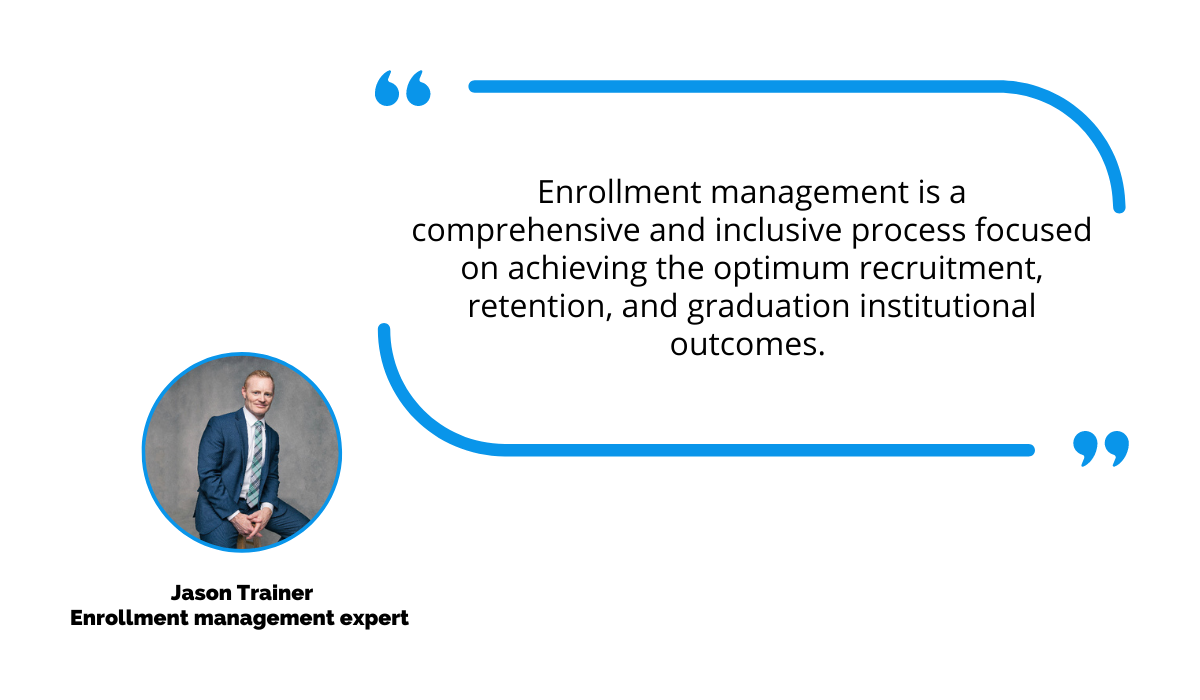
Illustration: Regpack / Data: Strategic Enrollment Management Quarterly
As you can see in Trainer’s definition, enrollment management covers the entire time a student spends in an educational institution, from recruitment to completing the program.
Although enrollment management as a term is coined and still used in educational settings, it’s important to point out that the context is broader today than it was in 1976.
Of course, managing enrollment today is important at schools and colleges, as it has been since the formation of the process.
For example, colleges develop detailed enrollment management plans that span several years and include various goals and objectives that need to be accomplished, as well as ways to do it, time frames, etc.
Below, you can see a part of the enrollment management plan from Southern Union State Community College.
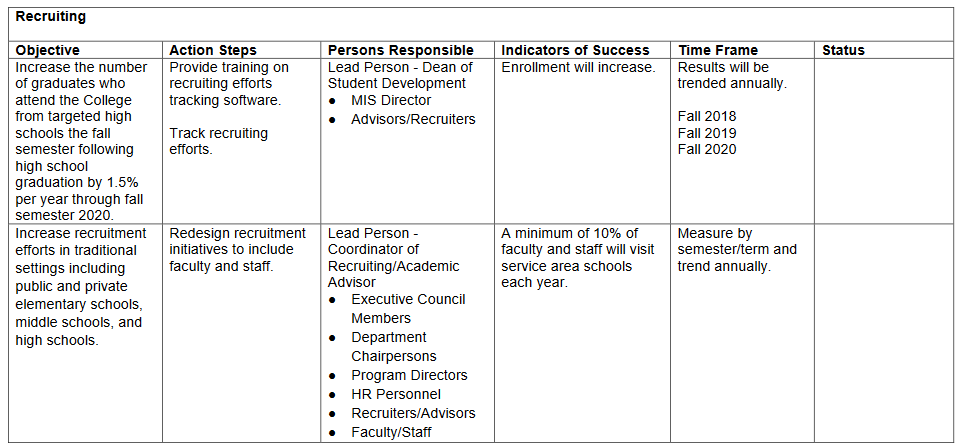
Source: Southern Union State Community College
However, it also encompasses other businesses that rely on enrolling people in their programs, like companies that offer courses, summer camps for children, etc.
In short, if you run a business that needs to attract, recruit, and retain people in its programs, enrollment management as a process can be beneficial for you.
In the following section, we’ll explore why.
Why Is Effectively Managing Enrollment Important
Enrollment management is important for multiple reasons. Let’s highlight some of them in this section.
First of all, regardless of whether you enroll people in your course, school, or camp, revenue is a crucial factor in your business.
There’s no way around it—money is important for every business.
Simply put, if you run a summer camp, the amount of money you bring in from enrollment can be a deciding factor if you’ll be able to organize the camp next year or not.
Colleges also heavily rely on enrollment revenue. For example, according to data from the National Center for Education Statistics, tuition and fees are constantly rising.

Source: Education Data Initiative
As you can see, be it a public or a private college, the revenue those institutions bring in per year per student has steadily increased in the last 35 years.
Therefore, the amount of money from enrollments is higher, so managing enrollments is increasingly more important.
Let’s move on to another reason why enrollment management is essential.
The research that goes into the process, which we’ll cover in more detail in one of the later sections, can provide valuable data.
What can you do with that data? A lot. You can use it to improve your attendees’ experience, enrich your programs, position yourself on the market better, etc.
For instance, Michigan State University’s sports camps are popular, and there’s a wide variety of them, each centered around a particular sport, such as gymnastics.

Source: MSU Gymnastics on Twitter
As you can see above, they offer two levels of high-performance camps.
The enrollment management process allows you to assess the needs of your participants, whether you manage enrollment in a sports camp, STEM camp, or a school.
That data can give you more control over what you offer and lead to more revenue and more successful programs in the end.
Those are only a few of the benefits enrollment management can bring you. However, for the process to be effective, you need to cover its key areas.
Let’s discuss them in the following section.
Key Areas of Enrollment Management
Enrollment management consists of multiple different areas, which combined create a process that benefits both businesses and participants in the programs.
Generally, there are four distinct key areas of enrollment management.
For example, according to The NAIS Enrollment Management Handbook by Christina Hailer Baker, enrollment management has these key areas:
- Admission management
- Retention
- Research
- Marketing
Let’s examine each of these areas in more detail.
Admission management deals with applications, registrations, admissions, and other aspects of turning potential participants into enrolled ones.
For example, that area also encompasses orientation for interested young people if you are running a summer camp program.
You can see an example from Fox Valley Family YMCA below.
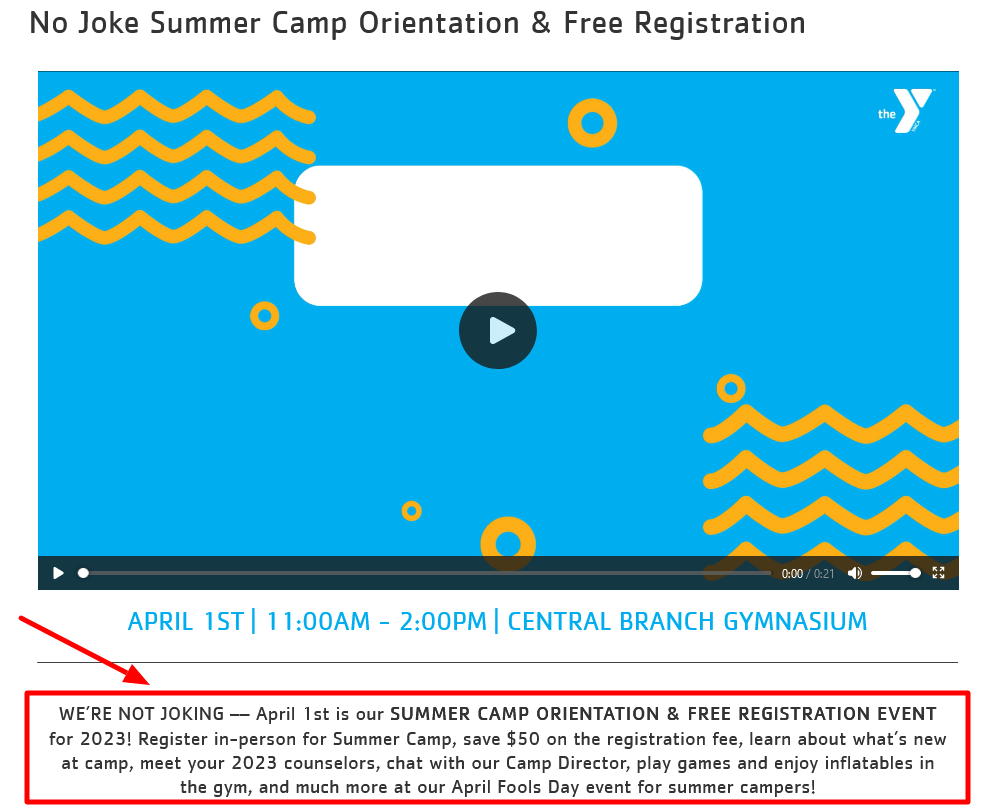
Source: Fox Valley Family YMCA
As you can see, they organize a meeting where they present their program, introduce counselors to potential campers, etc.
The efforts of admission management should result in many enrolled participants. Then the second key area, retention, is crucial.
Retention is responsible for re-enrolling students, campers, or participants of other programs you organize year after year.
That’s a key area because regular participants bring regular revenue and also boost your reputation.
How would it look if, for example, most students drop out of your programs every year before they finish them? Not great, to put it mildly.
Christina Hailer Baker, which we’ve mentioned earlier, defines the next key area of research like this:
Research involves collecting and analyzing data on internal and external factors affecting enrollment, student success (including retention), and your school’s image.
Although she talks about research in the context of educational institutions, the same principles of collecting and analyzing data that affects enrollment stand for any type of enrollment-based program.
The point of research is that you have access to data that can help you improve and adjust your offerings, bring in more attendees, and carve a stronger position among competitors.
Finally, marketing is about how you promote your business and the image you create to attract people to your programs.
There are many ways to market your business, and one of the most common and effective is your website.
For example, Western Governors University uses alum testimonials to showcase their value to prospective students.

Source: WGU
Combining these key areas of enrollment management will make the process seamless and more efficient, increasing the success of your business and the satisfaction of your customers.
Roles and Responsibilities in Enrollment Management
As you probably know by this point, enrollment management is a complex process that takes a lot of planning and effort to produce the desired results.
That also means that it takes a team of people with dedicated roles and responsibilities.
How many people are on the team depends on many factors; it’s not the same if you want to implement enrollment management in a private college or a sports camp.
One will be more complicated than the other because of the sheer size of operations on every level, from recruiting to financial management.
However, today, enrollment management undoubtedly needs a team, unlike in the early days of the process, as Eduventures explain in their white paper:
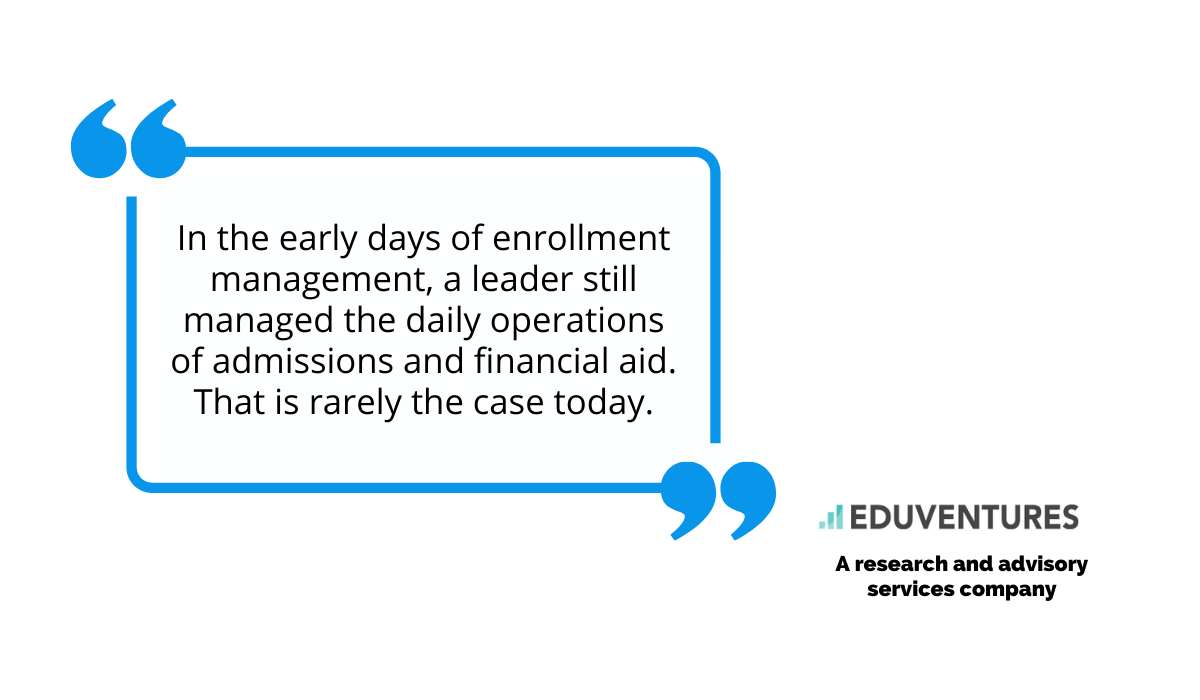
Illustration: Regpack / Data: Eduventures
So, what are the roles and responsibilities in enrollment management?
As we’ve mentioned, that can be different depending on the type of business, but the key roles and responsibilities are often the same.
For example, as the team from Blackbaud, a company that develops tech solutions and nonprofit software, writes in their blog, these are the vital roles when it comes to enrollment management in educational institutions:
- Enrollment manager
- Admissions director
- Financial aid director
- Marketing and communications coordinator
- Registrar
- Academic advisor
- Student life coordinator
As you can see, that is a sizable team of people, each with a distinct role.
You can read more about what each of them is responsible for in the blog post linked above the list.
Organizational Models for Enrollment Management
Enrollment management can be organized in different ways.
Each model has its own distinct characteristics and purpose, so which one you choose depends on your needs.
Let’s explore the four organizational models in the following subsections.
Enrollment Management Committee
The enrollment management committee is the first organizational model that is usually established.
As Garlene Penn states in an Enrollment Management for the 21st Century report, forming a committee is often “the first response of an institution to an enrollment-based problem”.
The committee is composed of multiple members who represent different groups.
For instance, in an educational setting, you can have administrators, faculty members, and even students.
Below, you can see an example of that in the enrollment management committee of City College of San Francisco.

Source: City College of San Francisco
Since the committee is, by definition, comprised of multiple people, its advantage is that it encourages discussion and diversification of ideas and opinions.
However, as Penn argues, it has little authority and power to make a significant impact.
Enrollment Management Coordinator
Your enrollment management efforts can have a person who is the face of the whole process.
That person is an enrollment management coordinator.
If you organize your enrollment management around a coordinator, they will be in charge of coordinating various other roles and responsibilities, such as financial aid, admissions, registrations, and others that are closely linked to participants in the programs you organize.
An enrollment management coordinator can be useful in various businesses and institutions, from educational institutions to tech companies.
For instance, you can see that in the job ads at Zippia below.
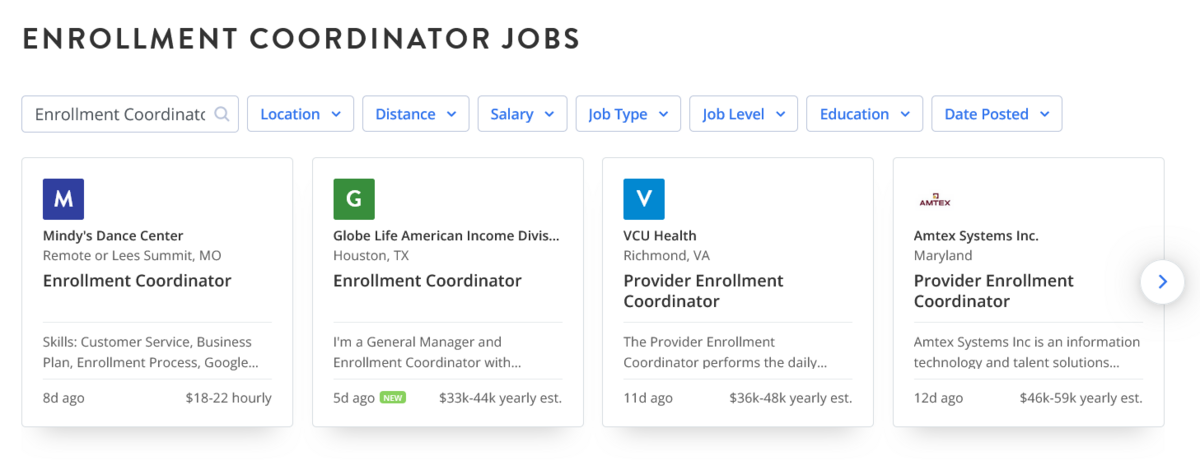
Source: Zippia
However, as Brian A. Vander Schee points out, a disadvantage of this model is that a coordinator has no direct authority to implement changes to the process if they are necessary.
Enrollment Management Matrix
While the committee isn’t a centralized organizational model for enrollment management, and having a coordinator is a step toward centralizing the responsibilities in one figure, the matrix model continues down that path.
In an enrollment management matrix, a senior figure in an organization is responsible for coordinating enrollment management efforts.
That person oversees the work of other offices and departments with their own roles and responsibilities.
Although using this organizational model provides more control over the necessary decisions and changes, Vander Schee explains how it could be problematic:
The challenge is that this responsibility is simply tacked on to the duties already performed by the administrator and therefore may relegate enrollment management concerns as low priority.
In other words, you should avoid burdening one person with too many responsibilities in addition to the enrollment management efforts.
Enrollment Management Division
This is the most centralized organizational model of the four discussed in this section.
In this model, one person holds the most responsibilities regarding enrollment management.
If you opt for this organizational model, you will also need to make some structural changes in your organization.
For example, the person responsible for enrollment management is usually the new position of vice president, which is a link between the head of the organization and the departments.
The departments themselves can be organized into one division for enrollment management.
For example, that division might include:
- Marketing
- Recruitment
- Financial aid
- Retention
- Orientation
Those are only some of the units that are in this organizational model all tied together and report to one person.
The highly structured and centralized approach to enrollment management has its disadvantages, mainly the need to restructure the organization.
How to Successfully Manage Enrollment
Now that we’ve learned what enrollment management is, why it is important, and more details about that beneficial process, let’s explore how to manage enrollment successfully.
To achieve that, you should be clear about the position and image of your business on the market.
Why? Because that way, you will know who your target audience is and develop strategies on how to reach them.
Whether that would include social media campaigns, content marketing, organizing open doors events, or some other way of reaching out to potential attendees of your programs and activities depends on various factors.
Regardless of the details, to successfully manage enrollment, you need to know who you want to enroll.
For instance, take a look at a tweet from the New City School:

Source: New City School on Twitter
You can see several elements in their tweet which indicate that their enrollment management team did their homework.
For example, they organized a summer camp in August, but they started their enrollment efforts in March.
That gives families plenty of time to enroll and maximizes the chances that the summer camp will be full.
Furthermore, the tweet specifies the age group for the camp, which means that the team behind enrollment management knows their target audience.
Lastly, the whole enrollment process is online, which is convenient both for interested campers and for gathering and processing data about them.
If you use great online registration software to manage enrollment, everything we’ve mentioned in this section can be much easier.
For instance, Regpack, our own solution, allows you to create online enrollment forms and uses conditional logic to provide a personalized touch when customers fill them.
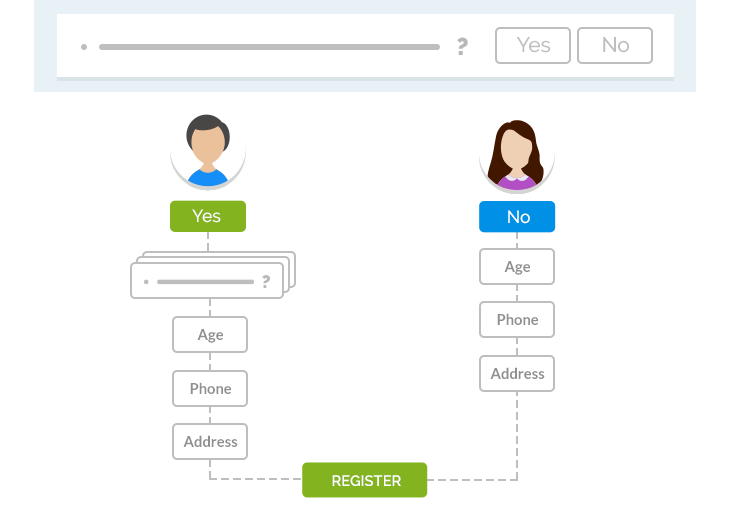
Source: Regpack
In a nutshell, that means the software guides the applicants through the registration process based on their answers.
Regpack also has powerful data-collecting capabilities that enable you to create reports, examine statistics, and filter your applicants in various ways.
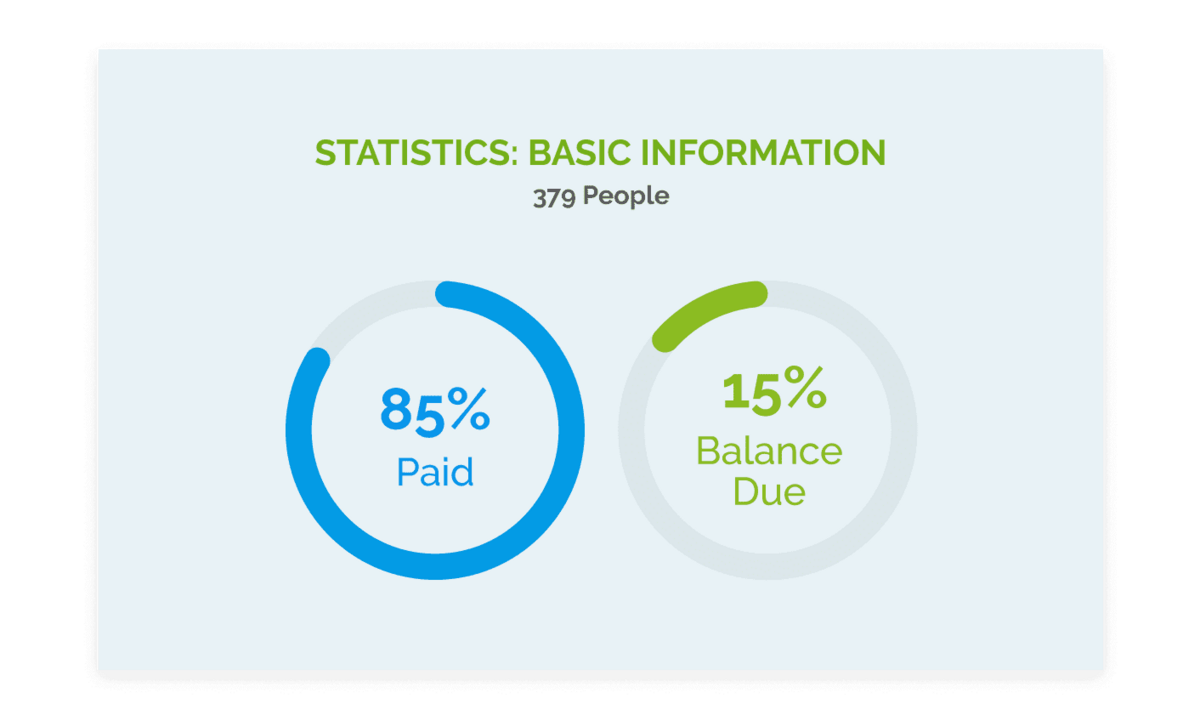
Source: Regpack
That helps you get to know your applicants and target your audience better in your enrollment efforts.
Using a software solution like Regpack can undoubtedly improve your enrollment management, and it’s integral to the success of the process.
Conclusion
In conclusion, enrollment management can make a difference between successful and failed businesses.
If your business model relies on attracting people and enrolling them in your activities and programs, managing enrollments is something you should undoubtedly master.
This article is a great starting point for that. We hope it will encourage you to explore more and lead your business to new heights.


















